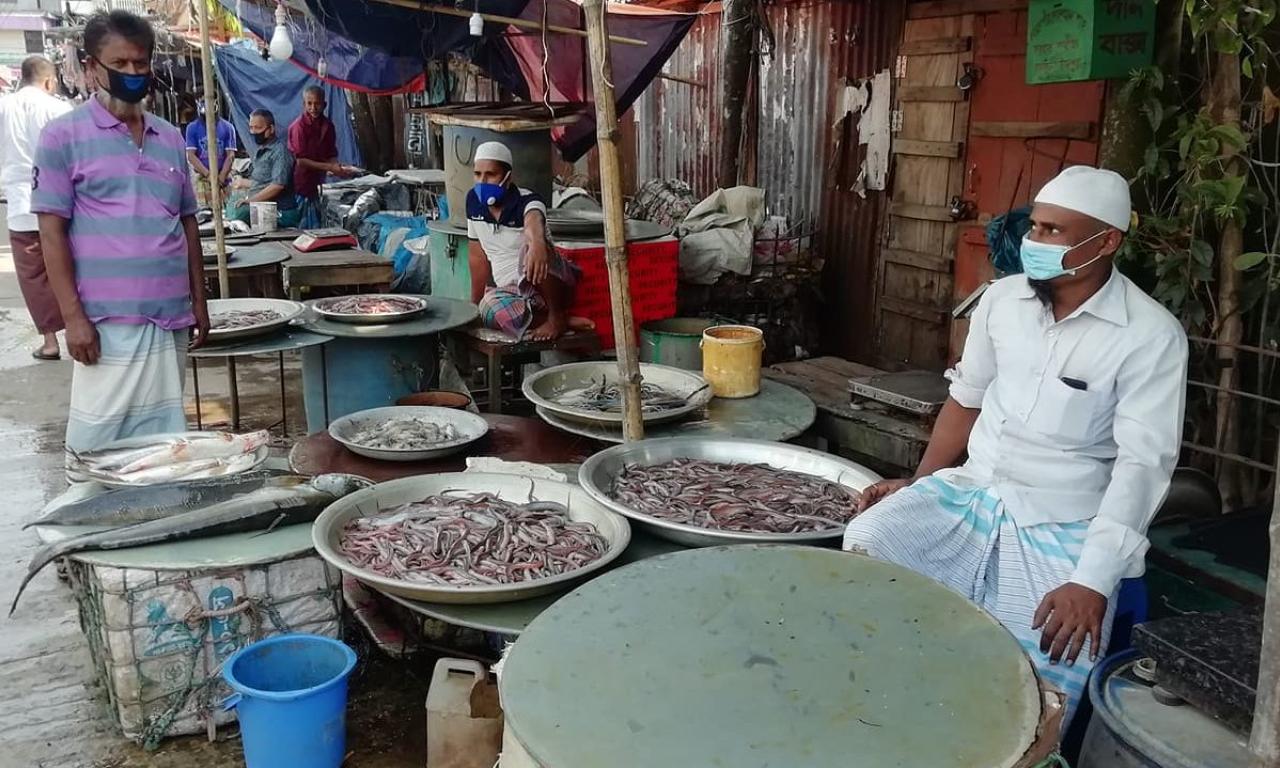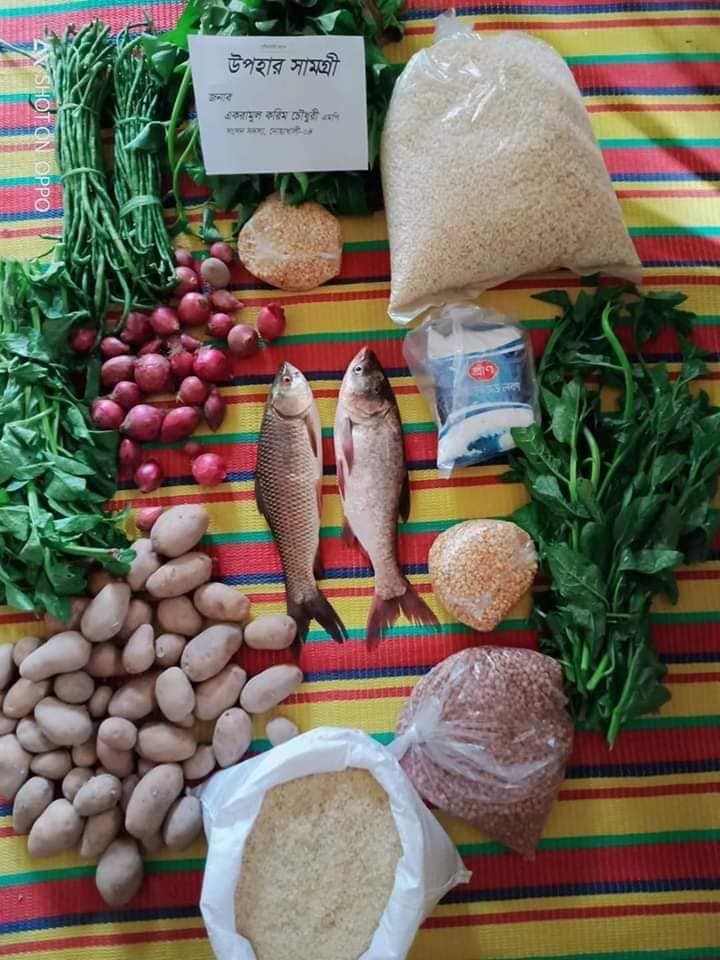
In this series of blogs, experts from WorldFish’s focal countries share their personal insights on the impacts of COVID-19 on fishing, aquaculture, and everyday life.
From food security to supply chains, here are some observations and experiences from Bangladesh, shared by Dr. Mohammad Mahfujul Haque, Professor in the Department of Aquaculture at the Bangladesh Agricultural University, Dr. Abdullah-Al Mamun, Associate Professor in the Department of Fisheries and Marine Science at Noakhali Science and Technology University and Mr. Mohammad Mamun-Ur-Rashid, Feed and Value Chain Specialist at WorldFish Bangladesh.
Preventative measures: A general sense of confusion surrounded the beginning of the pandemic as many people struggled to adjust to the new reality and understand what was permitted. Restaurants, hotels, and businesses selling non-essential goods were shuttered. Public transport was halted.
Social distancing rules proved to be difficult to enforce, and police were tasked with regulating movement on the streets. Police were especially active during the day, but movement by private transport at night was feasible.
For informal workers and those living under the poverty line, staying at home was not always a viable option because of their high dependence on daily wages. Even though measures are now being relaxed, the number of recorded cases has risen as testing capacity has increased. Fear may now be the biggest factor keeping people inside.

Impacts on food environments: The migration of factory workers back to their hometowns, changes in food purchasing habits, and fear of infection all contributed to decreases in consumer demand for food. Many factory workers lost their jobs and headed back to their places of origin, lessening demand for food in some urban areas. As many as eight million people were said to have returned home in the early days of the coronavirus pandemic.
Reduced operating hours, fears of infection, and measures to reduce the spread of COVID-19 have all contributed to changing purchasing habits, as the duration and frequency of market trips have fallen. The number of customers present in markets is estimated to have dropped by over a third. Market hours now vary widely across the country due to local restrictions and have a more limited range of opening times than usual.
For shoppers, going to the market now requires preparations such as wearing masks or gloves, and paying closer attention to the surroundings to maintain social distancing. Unnecessary outings are avoided whenever possible. People who might once have visited the market every day are currently only going about once a week. Older people often use rickshaws to go to the market, and their access may be affected by the decreased availability of this form of transport.
Alternative forms of shopping have become more common, such as ordering food by telephone or online with direct-to-door delivery or buying from mobile vegetable or fish vendors at customer’s doorstep or balcony. In some areas, markets in small streets have been relocated to more open spaces to facilitate social distancing.
Food availability: Major food shortages have not occurred, but supply chain disruptions have modified the usual foodscape. In Dhaka and Mymensingh, the diversity of fresh produce such as fish, fruits, and vegetables available in the market has decreased significantly, and items appear less fresh and appealing than usual. This reduced variety and diversity may have contributed to falling fruit and vegetable purchases.
The transportation disruptions and shortages of workers have caused supply issues for certain food items. Dr. Haque noted a sharp decline in overall fruit supply in Mymensingh, most notably for lemons, which are usually in high demand but could not be transported into the city from their point of origin, the South of Bangladesh.

Directives were issued early on by the Ministry of Fisheries and Livestock to encourage the smooth functioning of the fresh food supply chain. Nevertheless, problems were said to arise when police encountered trucks that were returning empty after making their deliveries. Some trucks have been charged movement fees, which has discouraged transportation across the food sector.
Changes diets: Changes in distribution, supply, and purchasing habits have impacted demand for perishable foods. Conversely, consumption of durable carbohydrates and legumes such as rice, potatoes and pulses may have increased, possibly substituting for animal sourced foods and vegetables. Prices of some imported fruits have gone up, but most locally produced foods are said to have remained affordable.
Poorer people may be eating less than before in absolute terms, while middle-class consumers may be reducing the diversity of foods consumed. Feelings of apprehension about the near future were said to contribute to households reducing portion sizes - for example by spacing out consumption of a single chicken over an entire week or dividing a whole fish into more portions than usual.
It is thought that urban dwellers are substituting more chicken and eggs for fish. Poultry farms are often located closer to consumers in urban or peri-urban areas than natural waterbodies and fish farms, meaning that fish may take longer to reach markets. Supply chains for poultry also appeared to be less affected than those for fish because chickens are more easily harvested, transported, conserved, and processed in the wet market. In addition, Mr. Mamun-U-Rashid noted fish production cycle in ponds could be easily extended while broiler chickens must be sold after about 45 days.
Consumers noted temporary fluctuations in chicken, egg, and fish prices in the early days of the pandemic due to a falling demand before prices gradually returned to normal for most products as measures were relaxed. Despite this, Dr. Mamun noted that some egg, poultry, tilapia and pangasius prices were still lower than usual. An early rumour that the virus could spread through fresh market produce may have negatively impacted the demand for fish and poultry, particularly at the beginning of the crisis. Demand for dried fish, which can be stored without refrigeration for extended periods of time, is said to have increased.
Changes in intra-household dynamics have reportedly led to a reduction of fish consumption. Many fish dishes require a lot of preparation and processing. Urban middle-class families who are typically regular fish consumers often employ a domestic worker to assist with preparing meals, but most of these workers have returned home during the crisis. Cooking now falls largely on the main female caregiver in each household, who does not have time for elaborate dishes. One interviewee noted that, as a result, their household was now eating only one of the four fish dishes regularly consumed. Woman also face additional pressure to supply all their households’ meal and snack requirements, as popular outdoor restaurants, cafes, and street food options are closed.
Countering food security threats: In response to the crisis, the Government of Bangladesh has provided food assistance to vulnerable populations. Food assistance most often includes staples and non-perishable items such as potatoes, rice, and oil. It is estimated that the government has subsidized food for around 50 million people and that 5 million poor households received BDT 2500 through mobile banking. However, the relief has not been sufficient for everyone, and Dhaka residents have noticed an increase in the number of beggars.
The government has prioritized rice procurement to assure staple food security. To this end, the Bangladesh Agricultural Development Corporation has purchased rice from farmers at high prices as a form of support. The initiative has not been extended to vegetable, fish, or poultry farmers.
Some political leaders and members of parliament have added fish as one of the relief items for vulnerable populations. A notable example is the food assistance authorized by the Member of Parliament in Noakhali in Southern Bangladesh, Mr. Ekramul Karim Chowdhury. Ten thousand families in his jurisdiction received 2-4kg of fish collected from local markets and adjacent coastal fish landing centres in addition to rice, onions and potatoes. Adding nutrient-dense items, which are usually absent from food aid packages, can help prevent malnutrition in vulnerable households.
In Narsingdi, a local entrepreneur Mr Muklesur Rahman, harvested more than 500 pangasius fish from his own farm for distribution to nearby families. Each family was gifted with a single live fish weighing around 2.5 kg. Mr Rahman said, “poorer people are struggling to get adequate nutrition during this pandemic, and this aid might help them to feed their family at least for a week”.

In part 2 of the blog, we will delve deeper into fishery and aquaculture disruptions by examining how COVID-19 impacted the aquatic supply chain, farmers and fishers.
